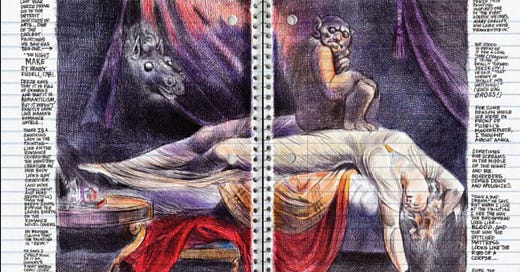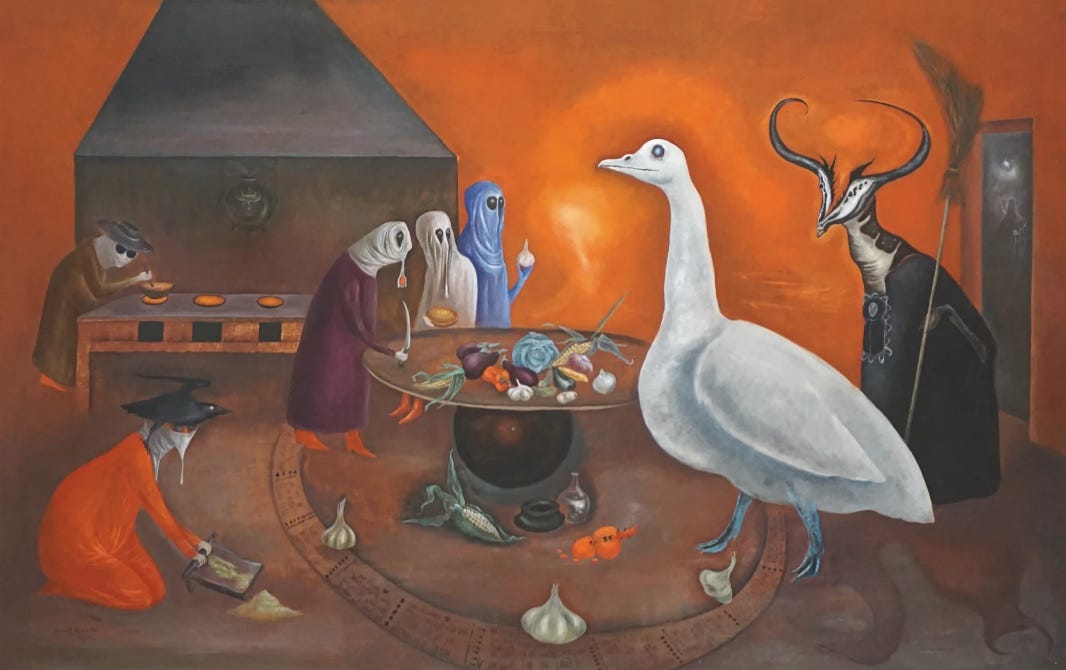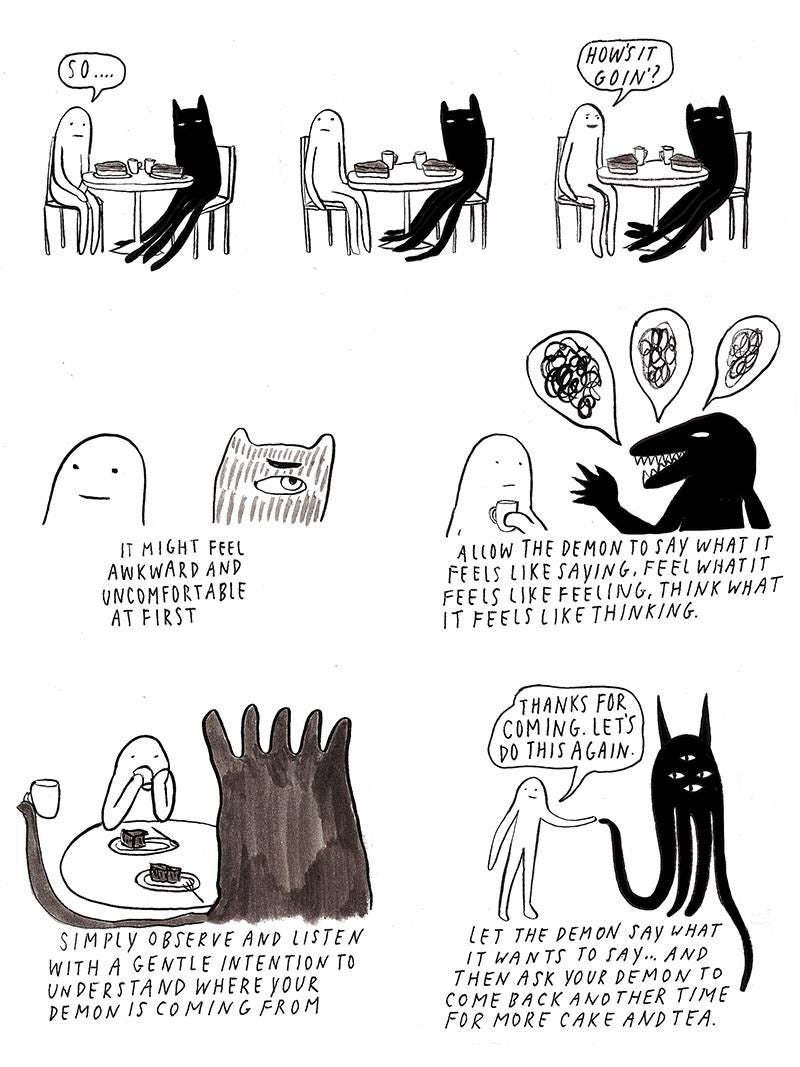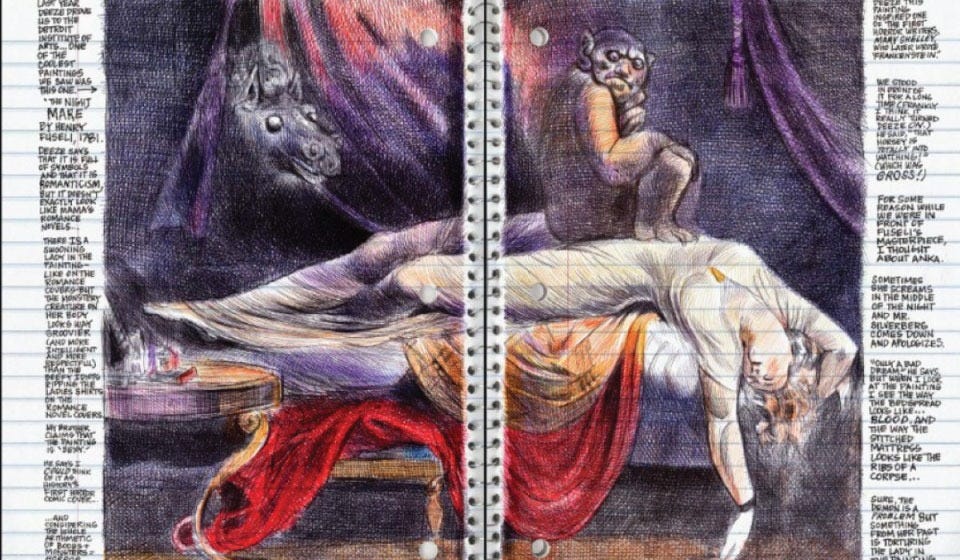‘It is a time in which the veil is thin, the air is thick with spirits and magic, a time to feast with the dead and divine the year to come, a time of delicious treats and mischievous tricks and pranks. The otherworld is palpable. The last of the crops would be gathered by Samhain, and much of the herds of livestock would be slaughtered and salted, their meat preserved for the winter months. This new year as a time of gathering in and preparing for the uncertainty of winter months. Mumming or guising during this holiday when the spirits were close may have also been a form of protection.’
- Mara June (from their grief magic course)
Halloween has always been my favorite holiday. I was a child who was way too into Edgar Allan Poe for her age, and with way too many cavities caused by my sweet tooth. Lately I’ve been casually researching monsters and had intended to share a post on feminist monstrosity.
However similar to October 2023, this year I once again find myself in no mood for celebration. Instead of using the monster as metaphor, the monstrous acts of humans have haunted my dreams and waking life. My family has its own death toll by now, and this month alone that number has almost doubled. I’ve had enough of horror, I’ve had enough of monsters (at least for now).
Instead I’ll be honoring Dia de los Muertos, de los Difuntos, de Todos los Santos. I’ll be volunteering at Green-Wood’s Day of the Dead event, adding my own ofrendas (ancestral offerings) to the Karanakuy community altar, and receiving a generous Nekya reading from NM Thomen of Orphic Astrology. I’ll share my thoughts on monsters at a later date. This season I need to grieve and spend time with the dead, but I’ll still share the post I had planned for today that was previously prepared. Whether you’re in the mood for mischief or mourning, I hope you find something that resonates.
☠️ SCENT
Heretic Parfum uses natural botanical ingredients instead of synthetics to create non-gendered perfumes that are vegan & cruelty free. They’ve had collaborations with heretics like Dita Von Teese, Violet Chachki & Bethony Vernon. For spooky season I propose Poltergeist, Monster Spray, The Blood Box, Season of the Witch, or the Gothic Gift Guide.
Another perfumery, D.S. & Durga, offers a Murder Mystery Perfume Set and Spectral Doorway, a scent inspired by Beetlejuice. The self-taught perfumer David Seth Moltz has shared on his newsletter Gonzo Fumes other limited edition Halloween Aromatics that have inspired them throughout the years.
🧟♀️ SIGHT
‘We've had cultural love affairs with all kinds of ugly monsters and it's not because we love them or enjoy seeing them...We tend to love monsters because they symbolize something in our real lives, something we're not fond of and in the movies we get to see the protagonists defeat or live alongside whatever terrible thing is causing them strife. We watch ourselves persevere in the face of extreme menace.
For instance, in anti-communist McCarthy era America, uber popular science fiction films depicted an America under threat from alien invaders, some of whom looked just like us. After the bomb was dropped on Japan, and they were dealing with fears of the nuclear age, Godzilla appeared to just ravage Tokyo. In the 70s as Son of Sam, Ted Bundy, and The Zodiac Killer were making national news, slasher films featured unthinking remorseless murderers.’
In the video quoted above by PBS Idea Channel, Mike Rugnetta argues that the resurgence of a particular monster in the 2010s, the zombie, was due to fears of encroaching technology but my sister reminds me that the history of zombies traces back to Haitian slaves who feared that even after dying, they would have to continue working on the plantation, imprisoned in their bodies and their souls enslaved forever. If you want to deep dive into this topic, there are more academic resources here.
‘Everyone told me a different story about how the slaves began to forget their past. Words like “zombie,” “sorcerer,” “witch,” “succubus,” and “vampire” were whispered to explain it. In these stories, which circulated throughout West Africa, the particulars varied, but all of them ended the same — the slave loses mother. Never did the captive choose to forget; she was always tricked or bewitched or coerced into forgetting. Amnesia, like an accident or a stroke of bad fortune, was never an act of volition.’
Educator, writer, gamer and pin-up Elexus Jionde of Intelexual Media has a whole playlist on spooky history, but she also offers a plethora of video essays on pop culture through the decades, sexuality, racism, politics, and more.
👻 SOUND
Heretic Parfum (mentioned above) used to have a podcast. Unfortunately their episode with Lesley Bannatyne about The History of Halloween has expired but I recommend their playlist (especially tongue in cheek track #23 La Bruja):
Alternatively, check out the new project Cosmic Valley Girl: The Mediumship is The Message by Michelle Pellizzon Lipsitz (of Holisticism & Spacies) and Emmalea Russo (astrologer & writer).
The podcast’s first season explores ghosts through film. Take a peak at their Undead Syllabus for some recommended readings plus media suggestions. Their episode on Alfred Hitchcock’s 1940 movie ‘Rebecca’ is free to listen to.
‘Ghost and geist share a root (spirit, breath….) and the ghosts of a particular pop cultural moment act as cool, freaky, and revealing guides to a zeitgeist. We shine digital and metaphysical light on our specters as we drop names, make associations, and think about routes into further areas of study. Here’s a heady and hardworking (undead, living, haunted…) syllabus for your ghosts and ours: past, present, and future….’
👹 TASTE
Have cake and tea with your demons as Yumi Sakugawa suggests:
Chaewon Koo similarly speaks of Feeding Your Demons, a shadow work exercise adapted from Tibetan Buddhist chöd by Lama Tsultrim Allione summarized by the following steps: write down a secret desire, write what is stopping you from getting that desire (the demon), visualize what the demon looks like and request its name, ask the demon to tell you its story of how it became a demon and why it does things to you, write how the demon is misunderstood and how it’s actually protecting you.
However, I enjoy Dori Midnight’s more literal interpretation of feeding demons:
‘our own creatures that populate the dark and deep: our anger and rage, our protective patterns forged in trauma and pain, the parts of ourselves we have submerged, pathologized and ostracized, our little fucked up demons and toothy monsters and hungry ghosts. And perhaps here we also find ancient and collective rage for all those who have been labeled monsters or called scary or crazy or too much, those who roar at injustice. Rage at all the ways white supremacy and ableism pathologize our righteous deviance and resistance, and all the ways so much of our distress and pain is caused by these very forces. What is a monster but a hunger, an unmet need with teeth and claws, a little inner lost one we shun and reject, and in response, they all become louder and hungrier.
What if we open to the rising wisdom of this luminous monstrosity? Can we court and befriend the monsters, offer honey and sweets to the demons, become the monsters, become the nightmare, become the darkness? Open our own mouths in a swell, a swarm of bees, a chorus of raging sea hags?
We offer honey to demons in a spirit sweetening ritual, which I think of as a kind of transformative justice for demons. This practice honors the fact that even demons have needs and are often just hungry and need healing, and we can offer something other than ourselves to consume. I also think honey serves as a delicious sticky lure for the parts of ourselves that we banish, abandon and deem unlovable. I like to place a bowl of honey on my altar for both/all kinds of monsters: honey for the demons who devour us and honey to call all our precious, monstrous parts back.’
🕸 TOUCH
What does horror have to do with healing? Margaret Bell, a thanatologist, counselor and somatic practitioner, argues in her newsletter that scary movies can be a means for healing grief and trauma. She suggests that we can view these films through a therapeutic lens, that horror can reflect our personal & cultural wounds, serve as an outlet, and help integrate complex emotions. She provides strategies for channeling anger through revenge films and somatic experiencing exercises for navigating your nervous system during horror. Explore her newsletter for movie suggestions & thoughtful reviews.
If you’re not in the mood for flicks, get your hands on some physical horror. Fantagraphics is hacking 30% off on crime, mystery, thriller, science fiction and scary stories until midnight. I’ll be purchasing my sister’s recommendation:
‘Set against the tumultuous political backdrop of late '60s Chicago, My Favorite Thing Is Monsters is the fictional graphic diary of 10-year-old Karen Reyes, filled with B-movie horror and pulp monster magazines iconography. Karen Reyes tries to solve the murder of her enigmatic upstairs neighbor, Anka Silverberg, a holocaust survivor, while the interconnected stories of those around her unfold. When Karen's investigation takes us back to Anka's life in Nazi Germany, the reader discovers how the personal, the political, the past, and the present converge.’
I hope you can spend some time with the demons & ghosts that haunt you today through art, myth, music, self reflection, or commemoration.










Such a brilliant synthesis of ideas and sensations. I love the message: humans are the worst of our monsters. Glad to have stumbled upon this!
You have such a talent for bringing together seemingly disparate ideas! I was so into this one. Thank you!